When looking for teams that will be likely to advance deep into the 2023 Women’s World Cup knockout stages, some of the names that will always be considered are the USA, England, Germany and maybe even joint-hosts Australia.
However, another team worth considering are Canada, who have always been one of the stronger sides in the women’s international game and who have generally been worth keeping an eye on at major tournaments. Unlike the men’s team, who accomplished a major feat by simply getting to Qatar, there is a lot more expected of the women, and the fact that they only lost three times in the whole of 2022 will only increase those expectations.
There is no doubt that, under the management of former England assistant Bev Priestman (who took charge back in 2020), they have become a successful side — with their free-flowing style of play helping them to the gold medal at the 2021 Olympics in Tokyo and a second-place finish at the 2022 CONCACAF W tournament, and this tactical analysis will examine her tactics in greater detail, looking at why the team has become such a force of nature.
Attack
When it comes to their attacking play, a lot of what they do well comes from their ability to push numbers forward in order to offer support to those already in that area of the pitch, and it is common to see lots of Canadian shirts in close proximity to each other as they look to apply pressure to their opponents.
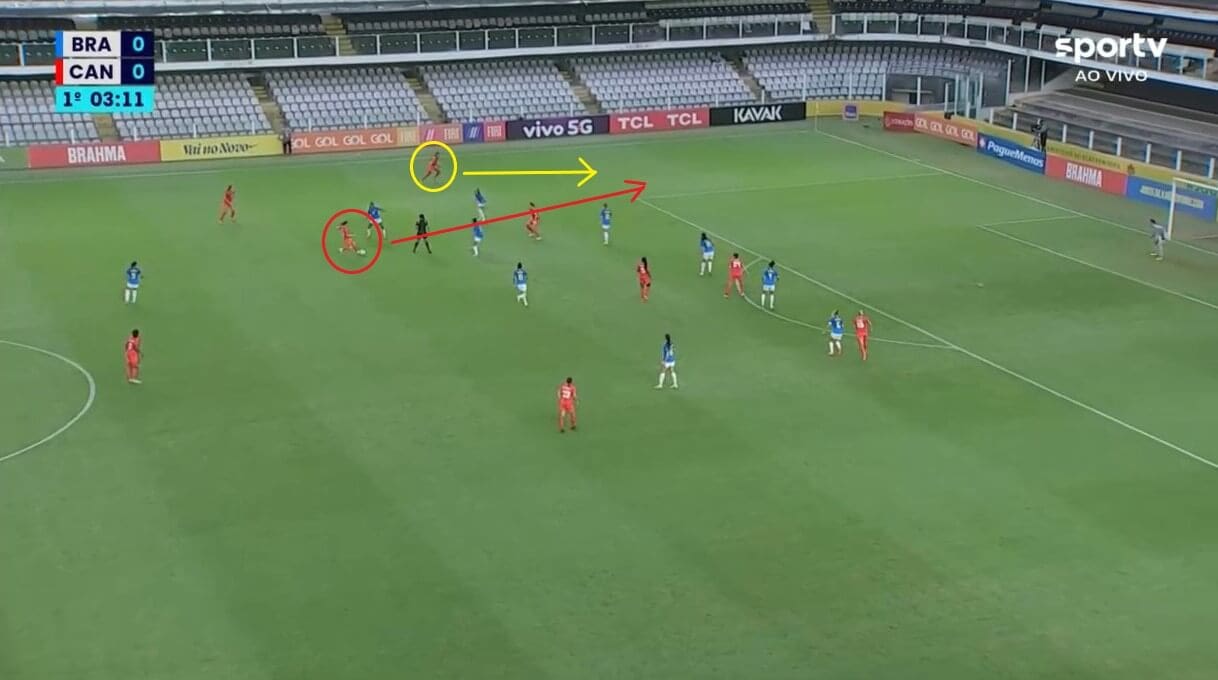
Two players who are central to that are the full-backs, with both expected to advance up the field as often as possible in order to control the wings and give the wide forwards the freedom to cut inside and position themselves nearer to the central striker. This then allows Canada to create numerical overloads and to retain possession for long periods of play, with their attacks always built on an ability to move the ball around at a good tempo and to wait for a gap in the opposing defensive line to open up.
Here, just such an opportunity has presented itself, with PSG Féminine’s Ashley Lawrence spotting the open space behind Brazil’s defensive line and making a run in order to give Chelsea Women’s Jessie Fleming a passing option, and the fact that it was a full-back who helped to move the ball through the defenders highlights, once again, just how important they are to Canada’s tactics.
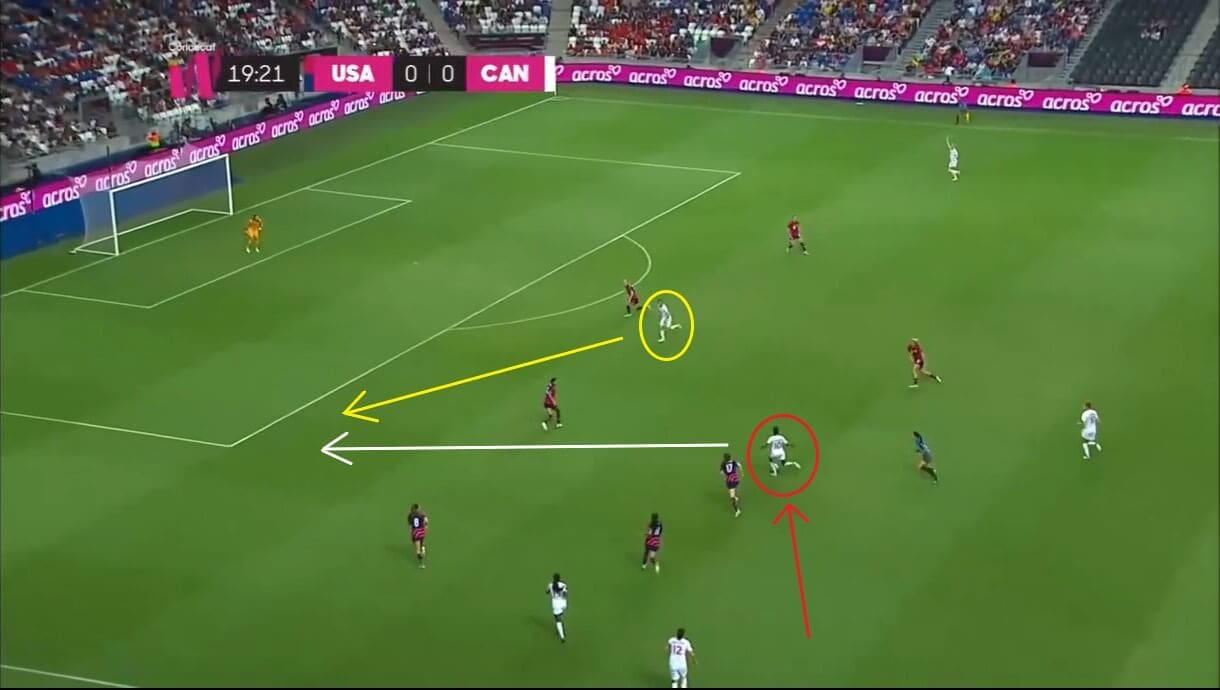
They aren’t just tasked with staying in the wide channels and offering passing options though, with them having just as much freedom to move infield and link up with teammates as the rest of the team does.
In this case, Lawrence has identified a route into the middle of the pitch and is doing just that, with the red arrow indicating her path. However, she is not simply looking to move the ball into the middle here, which is the key point, because her aim is actually to manipulate the USA (in this case) into leaving spaces open in their defensive line. As a result, she only travels a short way inside before sending the ball back towards the wing, with Fleming running across to get on the end of it.
These rotations between Canada’s players when they have the ball have been standard when they are in the final third, so it is something that they have clearly worked on during training and spent time perfecting, for which Priestman and her coaching staff deserve credit, and the fact that OL Reign’s Alana Cook and Portland Thorns’ Becky Sauerbrunn both got in each other’s way as they tried to react to each change of direction here demonstrated how effective it can be.
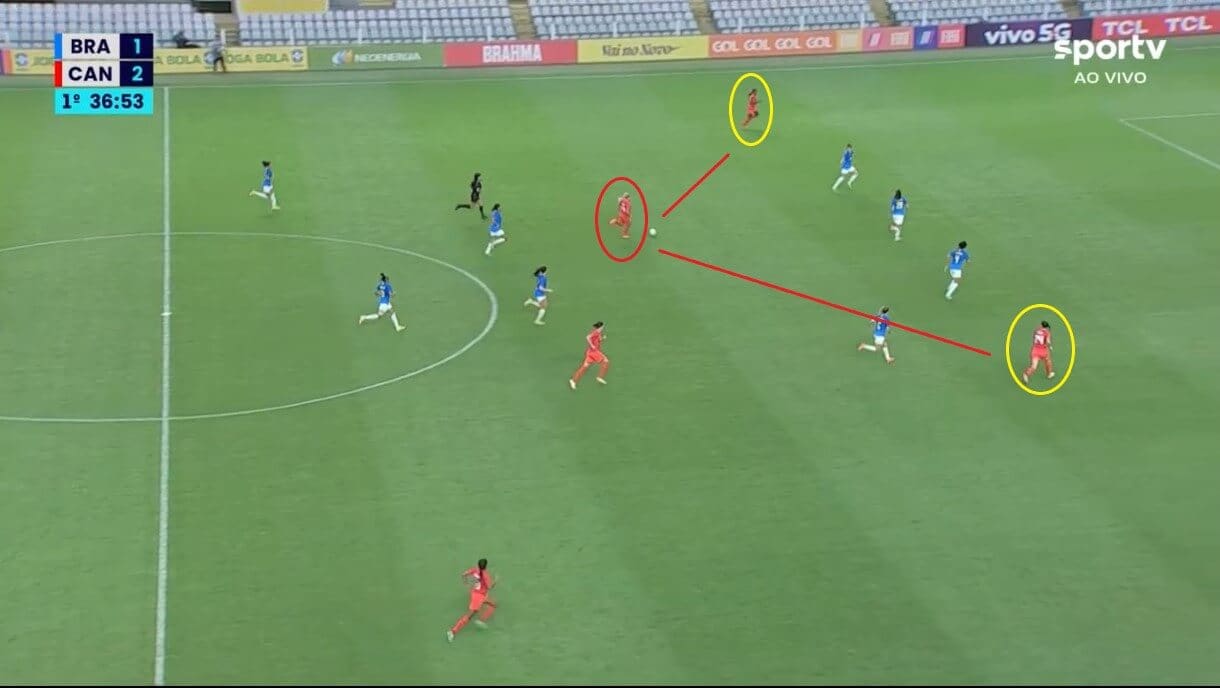
There are also clever tactical aspects to the makeup of other areas of their team too, with the balance of their forward line being vital if they are to win matches. Against Brazil, with their compact back line, the best option was to deploy Manchester United Women’s Adriana Leon at the top of the field and to use her natural ability to drop back and operate in deeper areas as a way of enabling Canada to move the ball across shorter distances.
However, as mentioned, it is a careful balancing act, because having two players who move into the same areas means that there is a strong risk of the team not having players in the areas that they need them to be in. As a result, with Leon dropping back so often, Canada needed to have two players on either side of her who were happy to stay in more advanced positions and to act as targets when the side had possession, and both Houston Dash’s Nichelle Prince and Kristianstads’ Evelyne Viens have shown throughout their careers that they are comfortable in those roles.
As with everything in this section of the analysis, the key point to make is that Canada are flexible and can adapt to different match situations, which is vital on the international stage with so many different styles of play on show. That is why, under Priestman and her tactics, they will be potential dark horses and ones to watch when the World Cup gets underway.
Midfield
However, in order to give the forward line opportunities to play so freely, those in the midfield need to be at the top of their game, with their main role being to help move the ball around the field during transitions and to provide either attacking or defensive support once possession has been conceded.
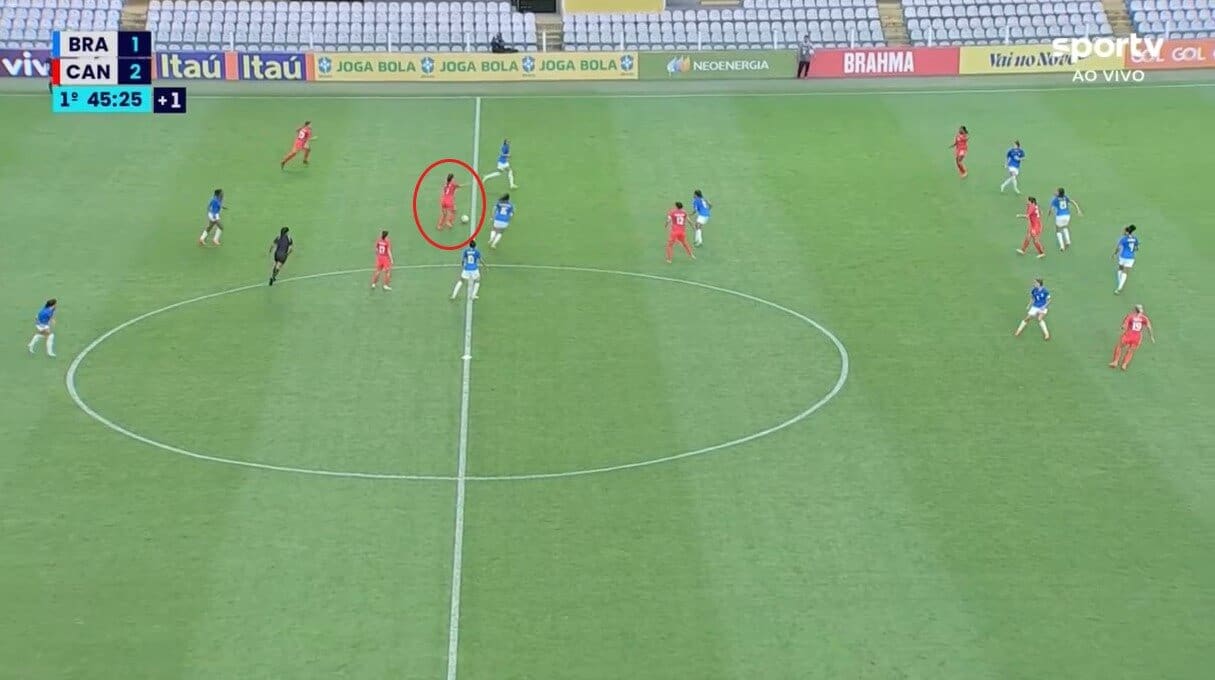
Fortunately for Bev Priestman, she yet again has players available to her who are perfect for those roles, with one of those being Juventus Femminile’s Julia Grosso. Since moving to Italy at the end of her college career with Texas Longhorns, the 22-year-old has gone from strength to strength and is now arguably one of the most underrated players in her position.
What makes her so important is her ability to keep hold of the ball in tight spaces, which is especially crucial in helping Canada to retain possession when options are not immediately available. As a result, the North American side can keep attacks alive and build in stages, which is not something that all teams can do as they don’t have players with the necessary qualities.
She also has a wide range of passing in her arsenal, with an ability to pick out teammates in all areas of the pitch, and that has been key to helping Canada again be adaptable and either build through shorter passes or play more directly, so she is a key part of her country’s tactics and will continue to be as they build towards their trip down under in the summer.
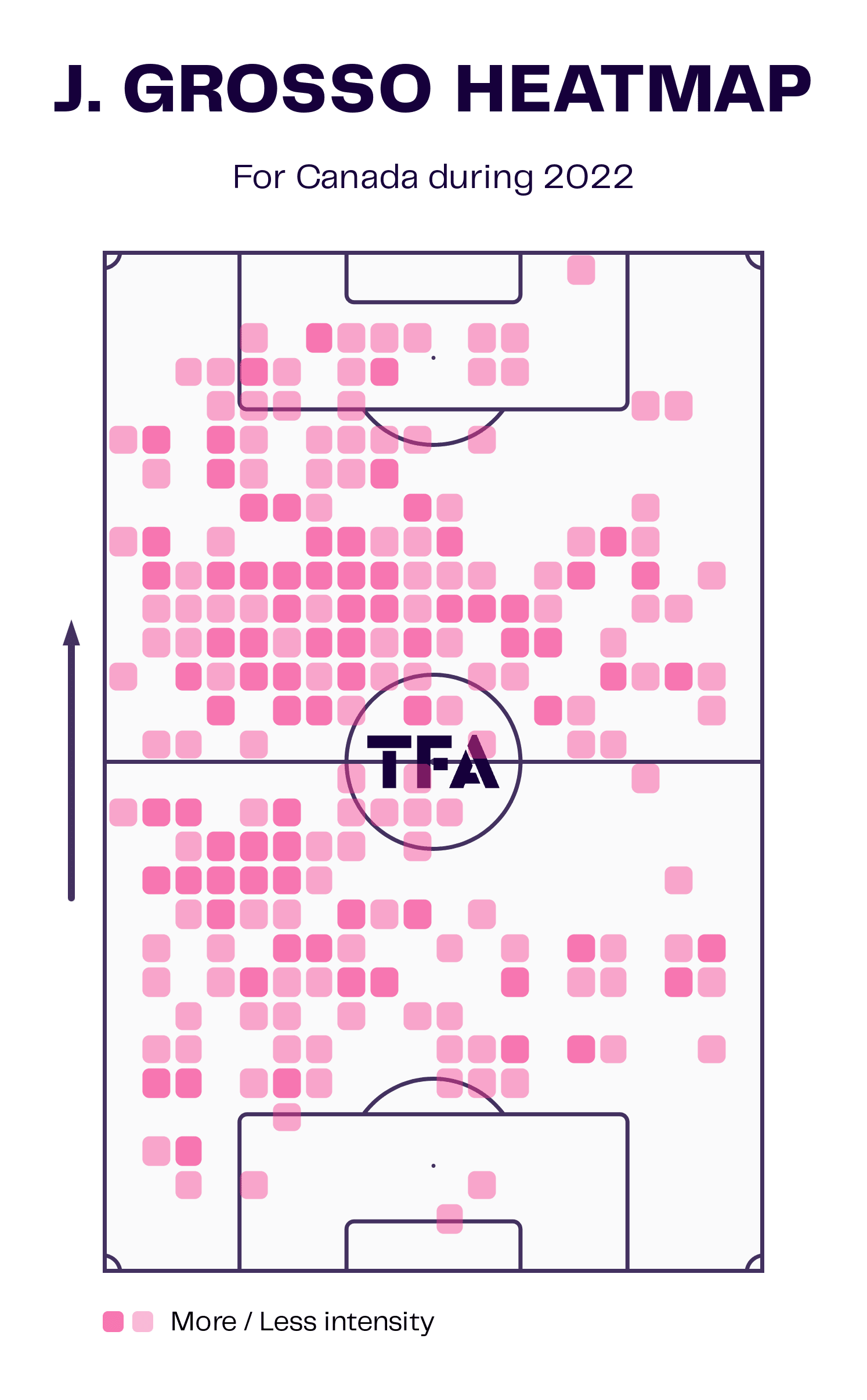
Her ability to control the tempo of games means that Canada need her to cover a large amount of ground, and this heatmap indicates how she involves herself in every third of the pitch. The fact that she offers so much on the field means that her teammates look to use her passing and hold-up abilities as often as possible, either to end threats or to create goalscoring opportunities, and Canada’s 82% passing accuracy for 2022 was in no small part down to her spatial awareness and the influence that she had on their performances.
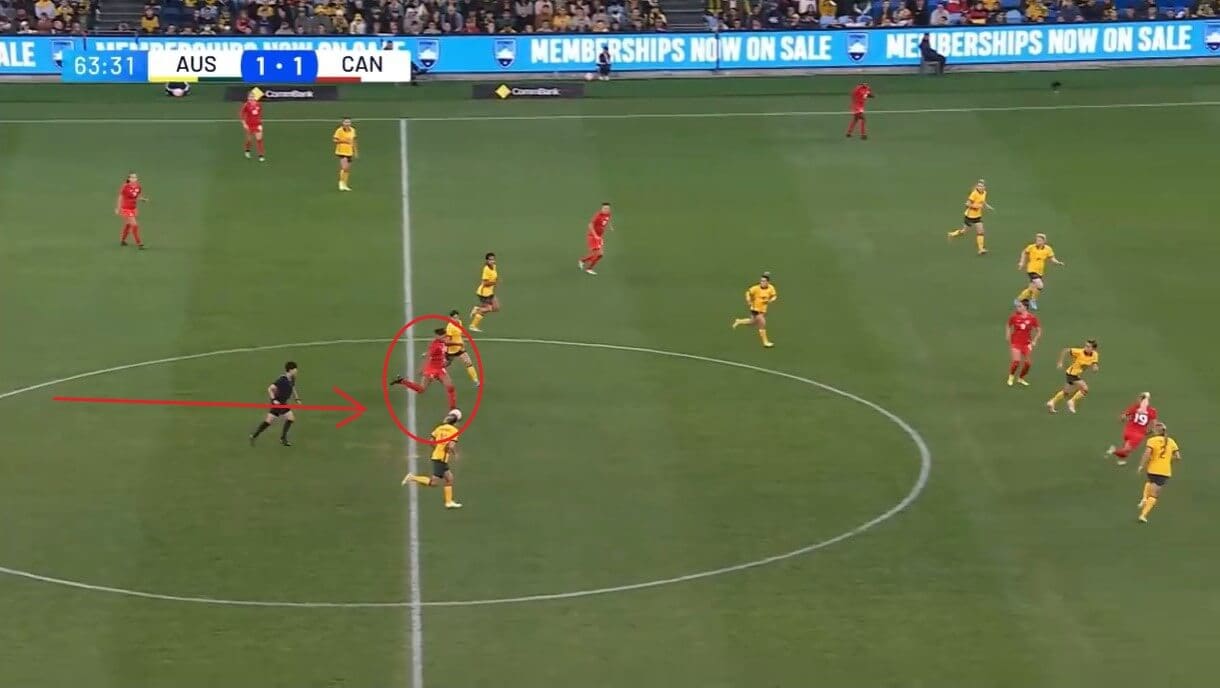
However, it is a team game and as with their forward play, Canada can switch things to give those roles to other players when needed. Against Australia, they played differently, with the midfielders tending to push higher up the field as Priestman looked to create numerical superiority in the final third. As a result, the defenders were tasked with keeping the ball for longer periods and passing it directly to the final third, just as Jade Rose is doing here.
Again, what this shows is that Canada are flexible in the way that they play, which is an important trait to have in international football, and it is clear that Priestman has worked hard to prepare her side for any eventuality as they look to make themselves tough opponents for any side to come up against during the coming year.
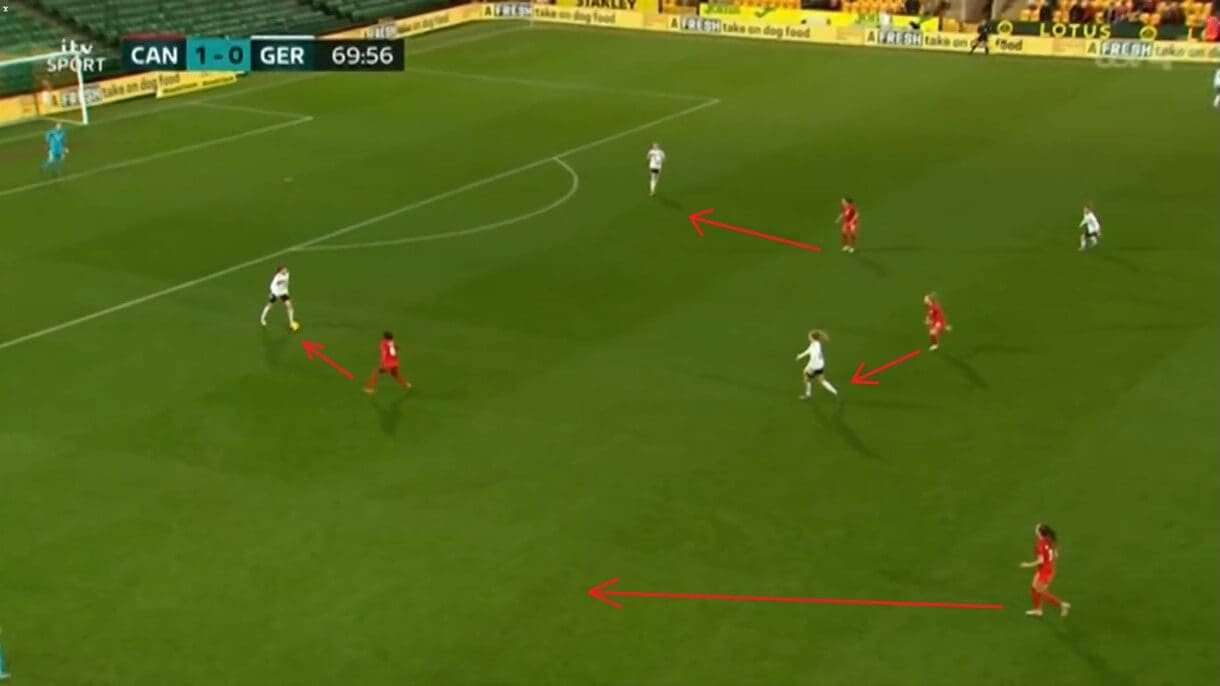
It has been mentioned that one of the main roles of Canada’s midfield is to be ready to press forwards or to drop back as required, and that comes into play here, with them needing to push into the final third in order to support the team’s forward press and limit Germany’s options as they look to play out from the back.
As the red arrows indicate, there is once again a strong element of organisation that goes into this, with each player involved knowing their role and selecting one opponent each. By doing so, they don’t leave spaces open and give their opponents an easy way out, and the fact that they don’t all press at the same time and instead move forward in turn in a calm and collected manner shows the teamwork that is central to everything that they have been doing well under Priestman’s management.
Defence
The theme of being adaptable and working as a team continues when analysing Canada’s defensive play, as Bev Priestman’s side once again have an organised appearance and know their roles; plenty of opponents have been left frustrated after coming up against the team currently ranked sixth in the world.
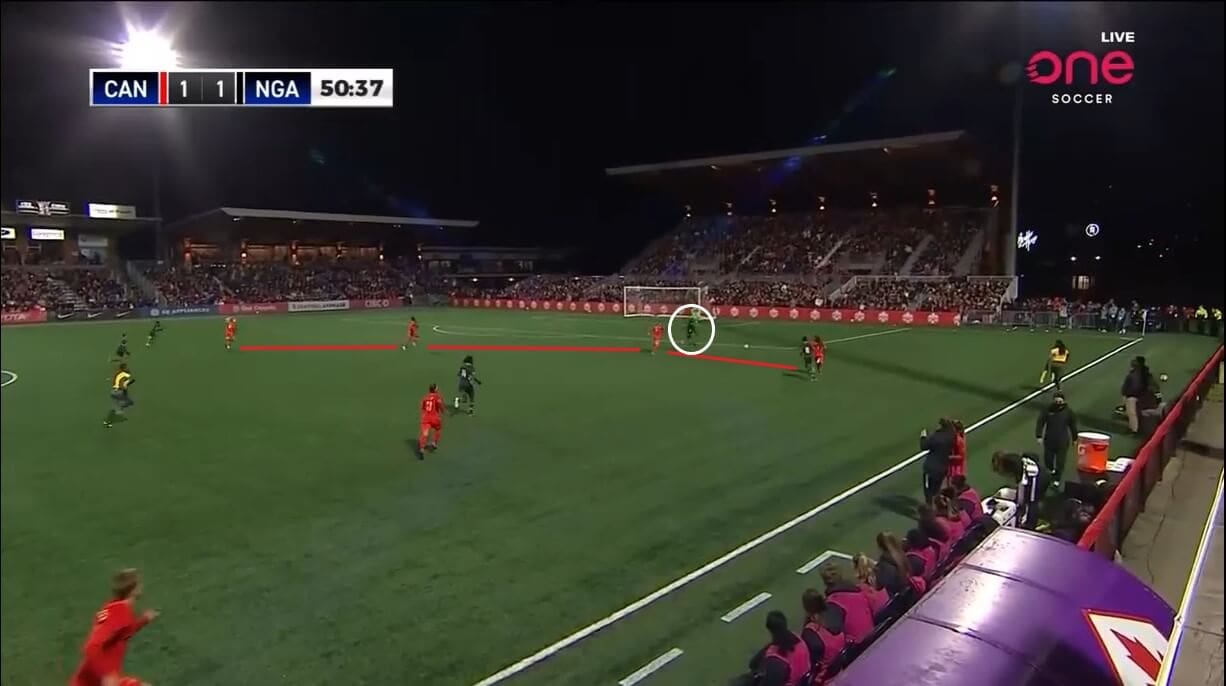
A common theme in Canada’s style of play is that they don’t always do what people are expecting them to, with them often implementing their own ideas on the field, and that theme continues when looking at how they protect their goal area. Here, they have a wide setup which initially appears to give Nigeria’s attackers an advantage, due to the amount of open space between each of the defenders.
However, this is actually a structure that Canada know works, as it provides them with a chance of simultaneously closing down individual players and protecting the spaces around their goal, making it twice as hard for their opponents to break them down. As a result, when Houston’s Michelle Alozie sends the ball into the path of Ifeoma Onumonu, Tottenham Hotspur Women captain Shelina Zadorsky can focus purely on tracking the NJ/NY Gotham striker and forcing her towards the goal line because she knows that her defensive teammates will cover the spaces available on the other side of the field. The fact that they only conceded an average of 0.56 goals per game throughout 2022 shows how, once again, they know their roles and work together to make themselves hard to beat.
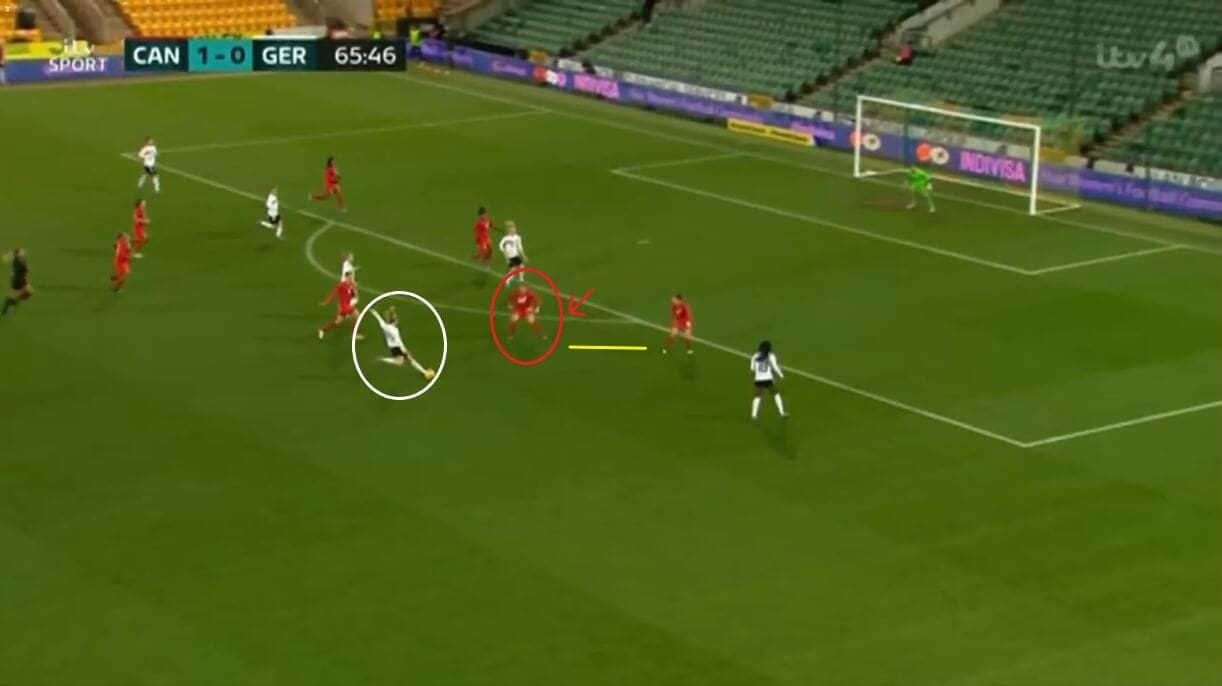
However, it should be mentioned that that wide setup is only used when Canada don’t have time to set up with a more conventional shape. When they do have that luxury, they can be just as effective at preventing their opponents from creating meaningful opportunities, with players again knowing what to do at every moment of the defensive effort. In this case, Hoffenheim Frauen captain Fabienne Dongus has possession on the edge of the goal area and is looking to shoot at goal, but Lyon Féminin’s on-loan centre-back Vanessa Gilles has come out of the defensive line to close her down.
This does two things from Canada’s point of view. Firstly, it forces Dongus to shoot at goal earlier than she might have liked to, with Gilles taking time away from the midfielder and secondly, it narrows the angle between Gilles and Allysha Chapman, as indicated by the yellow arrow, which means that Dongus now has less of a gap to send her effort through. Therefore, when combining both points, Canada looked to be on the back foot and then took control of the situation through their movement, and that is another reason that opponents have found them difficult to break down at times.
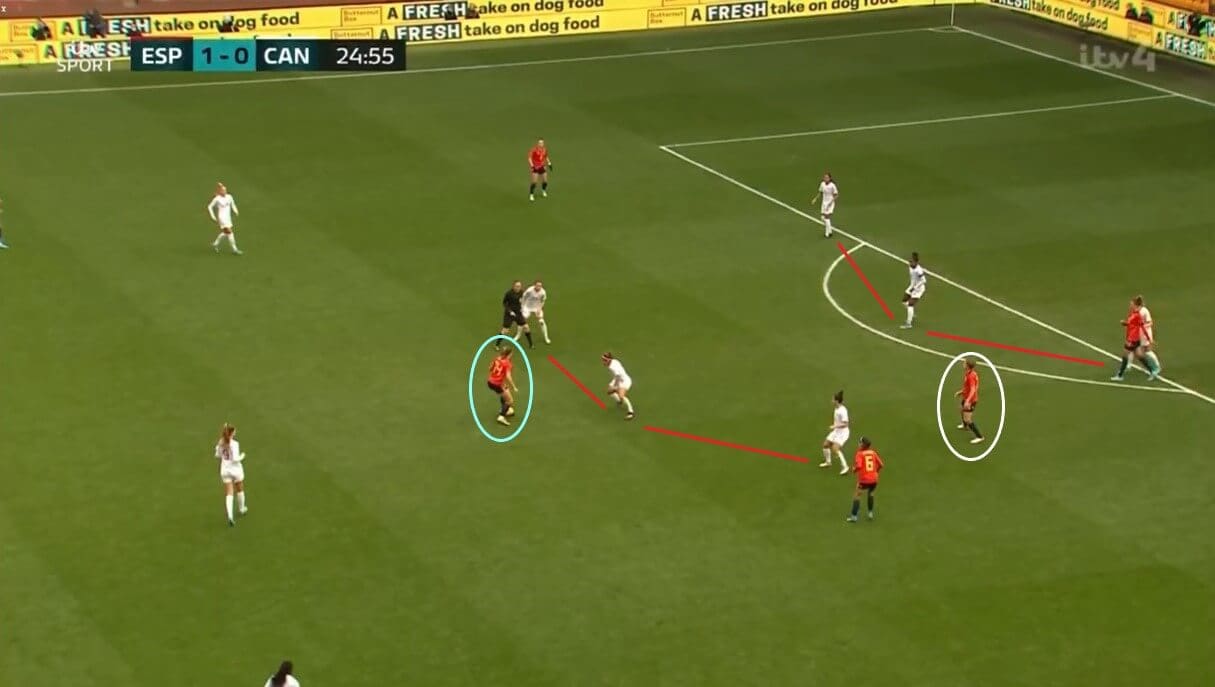
Occasionally, the defensive line have needed support from those in front of them to prevent goals from being scored, such as in this game, when the calibre of players that Spain had on the pitch meant that they posed a significant threat in Canada’s third, and this is when the midfielders’ ability to drop back comes into the equation.
However, for a low block to be effective, the two lines need to be close together, with no gaps opening up between them. On this occasion, that wasn’t the case, with Patri Guijarro able to receive a pass from her Barcelona Femení teammate Alexia Putellas in between the Canadian players, before having time to turn and transfer the ball onwards, and this happened several times as the European side dictated large parts of the encounter.
Therefore, whilst Canada are a strong side and will be expected by many to progress a long way into the World Cup finals, there are still some things that Priestman can keep working on with her players because these are the moments that could be the difference between a win, draw or loss.
Conclusion
In conclusion, this tactical analysis has looked in closer detail at Bev Priestman’s tactics with the Canadian women’s football team, focusing on each of the three sections of the pitch in turn and offering comment on why the North American side have been such an effective attacking and a robust defensive side.
However, whilst the tactics are something that the former England assistant has undoubtedly developed in her time with the side, what she deserves particular credit for is the way that she is always looking out for the next generation of talent and is never afraid of giving players chances to shine. Her squads generally include long-serving names like Portland’s Christine Sinclair, Chelsea’s Kadeisha Buchanan and Kansas City Current’s Desiree Scott, but also lesser-known players such as Chicago Red Stars’ Bianca St-Georges, Benfica Feminino’s Cloé Lacasse and Celtic Women’s Clarissa Larisey, with those players being rewarded for their good form at club level and picking up valuable experiences that will help them to prepare for the moment when the more experienced players hang up their boots.
All in all, the future of the Canadian women’s football team looks very bright with Priestman in charge, and they will undoubtedly be a team worth keeping an eye on throughout 2023.


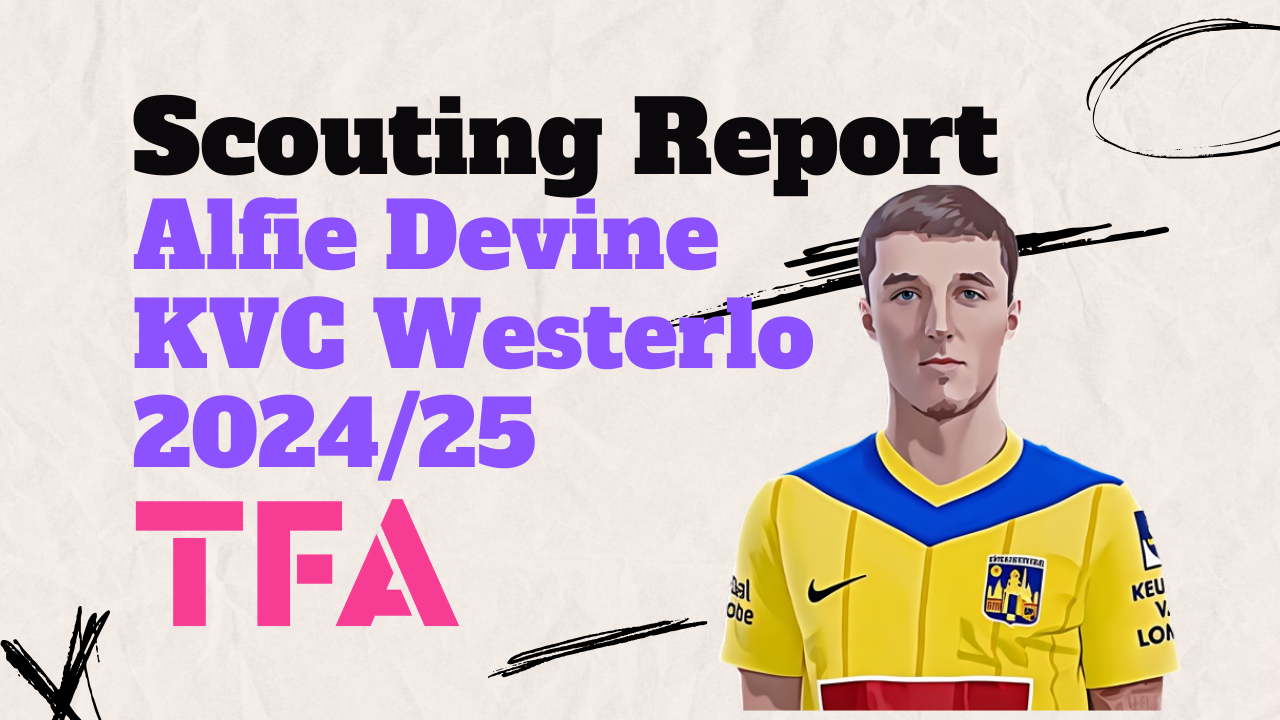
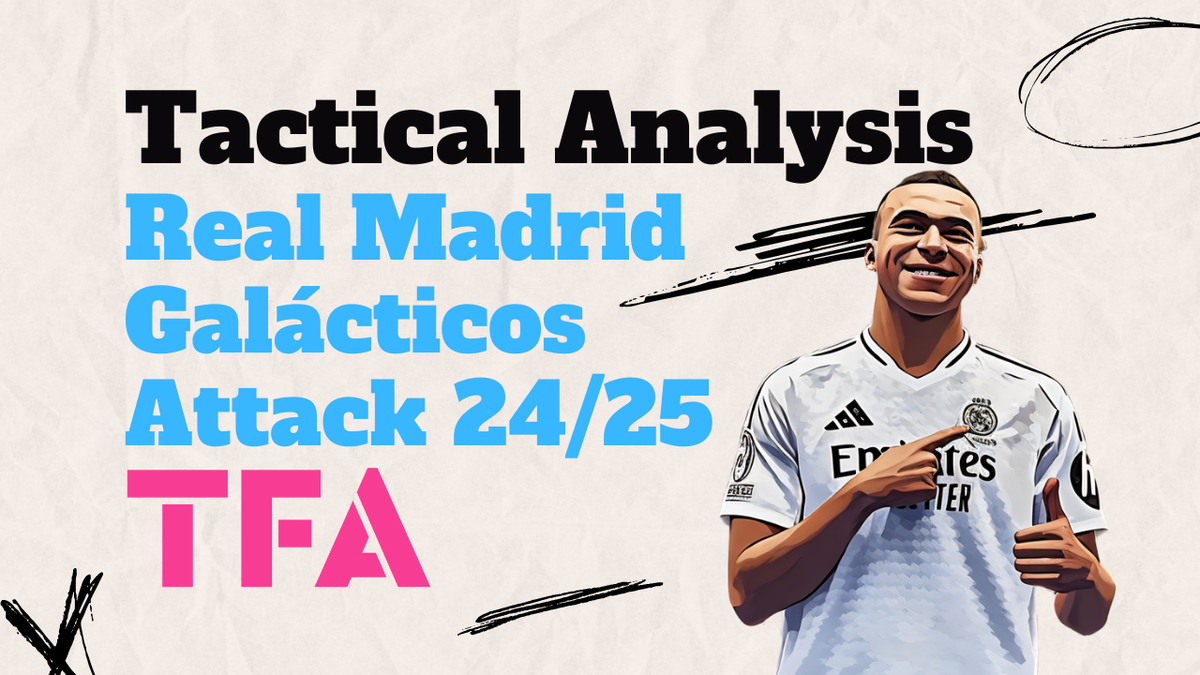
Comments